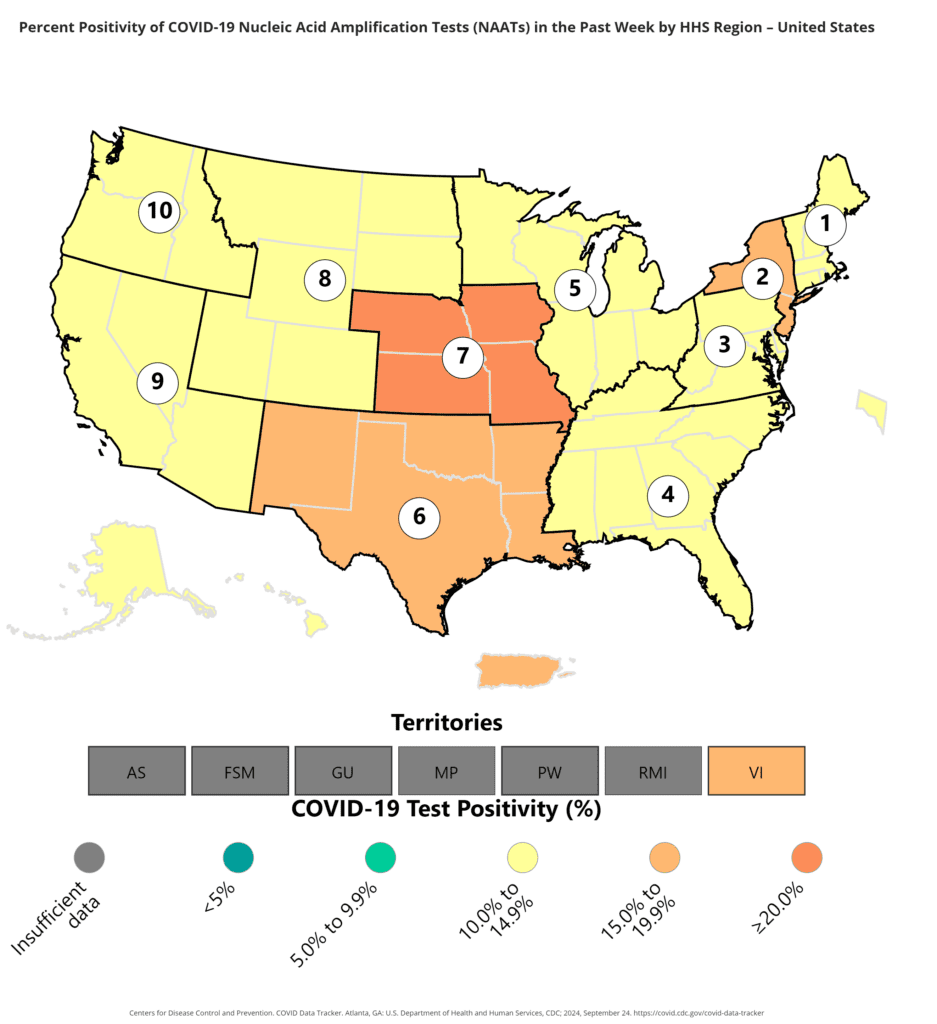COVID-19 rates across America have seen a sustained decline in recent weeks following a summer surge in coronavirus infections. However, some states are still seeing a rise in positive cases.
New data released by the U.S. Centers for Disease Control and Prevention (CDC) shows that the highest rates of infection are found in four Central states, with 1 in 5 COVID-19 tests coming out positive in these regions. Meanwhile, the most significant rise in cases has been seen in the Northeast.
Since the beginning of April, a group of highly infectious spinoffs of the Omicron variant have risen to prominence across the U.S. Nicknamed the “FLiRT” subvariants due to the positions of the specific mutations in their spike proteins, this new class of viruses now accounts for more than 80 percent of infections in the country, according to the CDC.
For the week ending September 7, the CDC reported that 16.3 percent of all COVID-19 tests performed in the U. S.—excluding at-home test results—were coming back positive. This is a 1.6 percent decrease from the previous week, but the infection rates have not been evenly distributed across the country.
The map below illustrates the distribution of positive tests in the U.S., divided into 10 Health and Human Service regions.
Map shows regions with the highest percentage of positive cases in the U.S. for the week ending September 7.
Map shows regions with the highest percentage of positive cases in the U.S. for the week ending September 7.
CDC
For the week ending September 7, the highest percentage of positive COVID-19 tests were seen in region seven—covering Iowa, Kansas, Missouri and Nebraska—with 20 percent of tests coming out positive.
The second highest rate was seen in region two—which covers New Jersey, New York, Puerto Rico and the Virgin Islands—where 15.7 percent of cases came back positive. Here, there were very low case rates throughout much of the summer, and the region is now seeing the fastest rate of growth in case numbers, with a 5.9 percent increase in case positivity in one week alone.
The lowest levels in the country are seen in region nine—which covers Arizona, California, Hawaii and Nevada—where only 9.7 percent of tests came back positive in the week ending September 7. This region has also seen the most significant decrease in case positivity, dropping 3.4 percent in one week.
Move than half all U.S. COVID-19 cases over the past two weeks have been attributed to the now-dominant subvariant, KP. 3.1.1; it belongs to the FLiRT group of viruses that emerged earlier this year.
However, while the U.S. has seen a steady rise in infections over the summer, hospitalizations have remained relatively low. The new FLiRT variants, while more infectious, do not generally cause as severe symptoms.
The symptoms include the following, according to the CDC:
Fever or chillsCoughShortness of breathFatigueMuscle or body achesHeadacheLoss of taste or smellSore throatRunny noseNausea or vomitingDiarrhea
More vulnerable individuals may still be at risk of severe illness, so it is important to self-isolate if you receive a positive COVID-19 test.
Is there a health problem that’s worrying you? Let us know via health@newsweek.com. We can ask experts for advice, and your story could be featured in Newsweek.
Source link : http://www.bing.com/news/apiclick.aspx?ref=FexRss&aid=&tid=66f2b821620148d083402b8f3cd10f29&url=https%3A%2F%2Fwww.newsweek.com%2Fcovid-map-update-states-highest-cases-cdc-1958506&c=2526109122734700798&mkt=en-us
Author :
Publish date : 2024-09-24 01:59:00
Copyright for syndicated content belongs to the linked Source.
